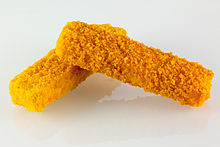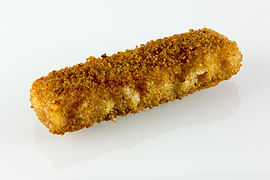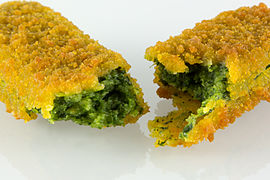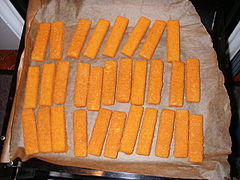fish sticks
Fischstäbchen ( Swiss High German also Fischstäbli ) are elongated, cuboid fish fillets that are breaded , pre-fried and offered frozen . In German supermarkets, they are the frozen products with the highest sales figures (as of 2018).
history
The original US company Birds Eye (now a trademark of Nomad Foods based in the British Virgin Islands ) took fish sticks in September 1955 at the United Kingdom to the market where the first fish fingers in the Birds Eye factory in Great Yarmouth were made . In the Federal Republic of Germany, the first fish fingers were manufactured by Solo Feinfrost GmbH in Bremerhaven in 1959 . In Austria they came on the market in the early 1960s.
In 1969 the first fish fingers were produced in the GDR by the VEB Fischkombinat Rostock . However, the fish fingers produced in the GDR were not fish fingers in their narrow technical definition, but breaded fish portions, as they did not consist of sawn fillet blocks, but exclusively of minced fish meat.
In 2012, total sales of fish fingers in Germany were just under 58,000 tons. Per capita consumption is increasing: 19 per capita were consumed in 2003, compared to 27 in 2017.
Manufacturing
Species of fish used

While herring fillets were initially used, the fish today comes mainly from the Pacific pollack ( Gadus chalcogrammus , trade name: Alaska pollock). In addition, the following types of fish (mostly white fish) are used:
- Atlantic cod ( Gadus morhua )
- Pacific cod ( Gadus macrocephalus )
- Kohler ( Pollachius virens , trade name: saithe )
- Hake (Merlucciidae)
- Pangasius ( Pangasianodon hypophthalmus )
- salmon
Due to the overfishing of the stocks, other alternatives such as the Pacific Hoki are also being considered.
processing
According to the guiding principles of the German Food Book, fish fingers contain at least 65 percent fish fillet, also cut into strips and / or with up to 25 percent minced fish meat; the weight of the individual breaded fish fingers is usually 30 grams. There are no specifications for the dimensions.
For production, the fish are usually filleted on board the fishing trawler , then examined several times and checked for bones. The largely boneless fillets are then frozen in flat plates. During further processing on land, these panels are sawn up and first covered with a wet breading consisting of potato starch , flour , spices and table salt . The breading that is then applied usually consists of breadcrumbs colored with paprika powder . The fish fingers are then briefly fried for a few seconds so that the breading forms a dry crust and aromatic roasted substances ( Maillard reaction ), but the fish fillet inside does not thaw. The color and consistency of the breading differs a little from country to country, depending on consumer expectations.
variants
Based on shape and prepare classic fish fingers, there are several variations on the market: So there are salmon Buds, Aerosols and "whole grain sticks" with whole wheat flour instead of simple wheat flour in the wet and dry-coating, Omega-3 -Fischstäbchen and fish sticks in baking fish - batter . The externally identical vegetable or spinach sticks, which are considered vegan products, get by without any fish . Similar to meat substitute products, breaded fish imitations are also offered in the form of chopsticks. There are also fish fingers with an organic breading.
sustainability
Some brands are marketed with the Marine Stewardship Council's eco-label , which aims to ensure responsible fishing practices and sustainable fishing.
preparation
The preparation takes place in a deep fryer , a pan or in the oven .
baked fish fingers on baking sheet with baking paper
Nutrient levels
A fish finger weighs approx. 30 g with a fish portion of 20 g. It has an energy content of around 250 kJ (60 kcal). 100 g fish fingers contain the following average nutritional values (using the example of Alaska pollock): 13 g protein; 8 grams of fat; 18 g of carbohydrates; 67 µg iodine; Vitamins B1: 110 µg, B2: 110 µg, B12: 0.8 µg; 13 µg selenium; 220 µg potassium; 37 µg magnesium.
literature
- Heidbrink, Ingo, Erik Hoops, and Katharina Jantzen. Fish Fingers: Fisheries and Fish Processing As Industrial Heritage; Proceedings of the 10th Conference of the North Atlantic Fisheries History Association Bremerhaven, August 7-11, 2006. Bremerhaven: Deutsches Schiffahrtsmuseum, 2008.
- Paul R. Josephson: The Ocean's Hot Dog. The Development of the Fish Stick . In: Technology and Culture, ISSN 0040-165X , Vol. 49 (2008), No. 1, pp. 41-61
Web links
Individual evidence
- ↑ "Taste is a big opponent" - brand eins online. Retrieved December 21, 2018 .
- ^ R. Pells: Fish fingers celebrating their 60th birthday: How a simple staple stood the test of time. In: The Independent September 13, 2015. Accessed September 15, 2015.
- ↑ https://www.bis-bremerhaven.de/hauptstadt-der-fischstabchen.98070.html
- ↑ Allgemeine Fischwirtschaftszeitung 21 (1969) 14.
- ↑ Heidbrink, Ingo, Werner Beckmann, and Matthias Keller (2003): And today there is fish !: 100 years of the fish industry and fish wholesaling in the spotlights 1903-2003. Bremen: HM Hauschild, 2003.
- ↑ [1] Statista: Sales of fish fingers in Germany
- ↑ a b c Bayerischer Rundfunk: How Alaska pollock becomes a stick .
- ↑ a b Stern.de/Denise Snieguole Wachter (October 11, 2019): What are fish fingers actually made of? .
- ↑ Annika Bangerter: The veggie fish are coming: More and more products are entering the market. In: tagblatt.ch . December 17, 2019, accessed December 30, 2019 .





